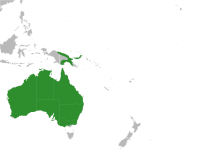| Pygopodidae | |
|---|---|

| |
| Lialis burtonis | |
| Scientific classification | |
| Domain: | Eukaryota |
| Kingdom: | Animalia |
| Phylum: | Chordata |
| Class: | Reptilia |
| Order: | Squamata |
| Infraorder: | Gekkota |
| Superfamily: | Pygopodoidea |
| Family: | Pygopodidae Boulenger, 1884 |
| Subfamilies | |
|
2, See text | |

| |
| Geographic range of the family Pygopodidae in Australia and New Guinea. | |
Pygopodidae, commonly known as snake-lizards, or flap-footed lizards, are a family of legless lizards with reduced or absent limbs, and are a type of gecko. The 47 species are placed in two subfamilies and eight genera. They have unusually long, slender bodies, giving them a strong resemblance to snakes. Like snakes and most geckos, they have no eyelids, but unlike snakes, they have external ear holes and flat, unforked tongues. They are native to Australia and New Guinea.
Pygopodids have no fore limbs at all, but they do possess vestigial hind limbs in the form of small, flattened flaps. These may have some role in courtship and defensive behaviour, and may even aid in locomotion through vegetation. Some species are insectivorous burrowing animals, but others are adapted to moving through dense spinifex or other vegetation.
Shared gecko characteristics
The pygopodids and other geckos share a number of characteristics:
- the production of parchment-shelled eggs in clutch sizes of two
- the ability to lick clean the clear spectacles that cover their lidless eyes;
- vocalization sounds like the common gecko “harsh squeak”.
- skull anatomy
- inner ears anatomy
- communal nests. Some nests have been found to have as many as 30 eggs.
Differences from snakes
Legless lizards are often killed due to their similar appearance to snakes. A number of external characteristics can be used to distinguish legless lizards (including the hooded scaly-foot) from snakes:
- Flap-footed lizards have vestigial hind limbs.
- Legless lizards have broad, fleshy tongues, dissimilar from the forked tongues of snakes.
- Most legless lizards have external ears.
- Ventral scales are in a paired series.
- Unbroken tails in legless lizards are much longer than the body, whereas snake bodies are longer than their tails.
- Can vocalise, snakes can not.
Hearing
Pygopodids can hear tones higher than any other reptiles. Individuals in the species Delma pax can respond to a 60-decibel sound with a frequency of 11,100 Hz, more than an octave above the highest note on a standard piano.
Taxonomy

Pygopodidae is one of several taxonomic families of geckos, and is most closely related to two other Australian gecko families Carphodactylidae and Diplodactylidae.
Classification
FAMILY PYGOPODIDAE
- Subfamily Lialisinae
- Tribe Lialisini
- Genus Lialis (two species)
- Tribe Lialisini
- Subfamily Pygopodinae
See also
References
- "Pygopodidae". Dahms Tierleben. www.dahmstierleben.de/systematik/Reptilien/Squamata/Gekkota/Pygopodidae.
- Gamble, Tony; Greenbaum, Eli; Jackman, Todd R.; Russell, Anthony P.; Bauer, Aaron M. (June 27, 2012). "Repeated origin and loss of adhesive toepads in geckos". PLOS ONE. 7 (6): e39429. Bibcode:2012PLoSO...739429G. doi:10.1371/journal.pone.0039429. PMC 3384654. PMID 22761794.
- ^ Bauer, Aaron M. (1998). Cogger HG, Zweifel RG (eds.). Encyclopedia of Reptiles and Amphibians. San Diego: Academic Press. pp. 150–152. ISBN 0-12-178560-2.
- ^ Shea, Glenn. "Fauna of Australia: Family Pygopodidae" (PDF). Archived from the original (PDF) on 24 August 2012. Retrieved 16 June 2012.
- ^ Patchell, Frederick; Richard Shine (February 1986). "Food habits and reproductive biology of the Australian legless lizards (Pygopodidae)". Copeia. 1986 (1): 30–39. doi:10.2307/1444884. JSTOR 1444884.
- ^ Wilson, Steve (2003). A Complete Guide to Reptiles of Australia. New Holland: Reed.
- ^ Wilson, Steve (2005). A Field Guide to Reptiles of Queensland. Australia: New Holland.
- Hoser, Raymond (1989). Australian Reptiles and Frogs. Pierson & Co.
- Manley GA, Kraus JEM (2010). "Exceptional high-frequency hearing and matched vocalizations in Australian pygopod geckos" (PDF). The Journal of Experimental Biology. 213 (11): 1876–1885. doi:10.1242/jeb.040196. PMID 20472775. S2CID 17996056.
Further reading
- Boulenger GA (1884). "Synopsis of the Families of existing Lacertilia". Annals and Magazine of Natural History, Fifth Series 14: 117–122. (Pygopodidae, new family, p. 119).
- Goin CJ, Goin OB, Zug GR (1978). Introduction to Herpetology, Third Edition. San Francisco: W.H. Freeman. xi + 378 pp. ISBN 0-7167-0020-4. (Family Pygopodidae, pp. 285–286).
- Kluge AG (1974). "A taxonomic revision of the lizard family Pygopodidae". Miscellaneous Publications, Museum of Zoology, University of Michigan (147): 1–221.
| Squamata families | |||||||
|---|---|---|---|---|---|---|---|
| Dibamia | |||||||
| Gekkota | |||||||
| Scincoidea | |||||||
| Laterata / Lacertoidea |
| ||||||
| Anguimorpha | |||||||
| Iguania | |||||||
| Serpentes |
| ||||||
| Taxon identifiers | |
|---|---|
| Pygopodidae | |